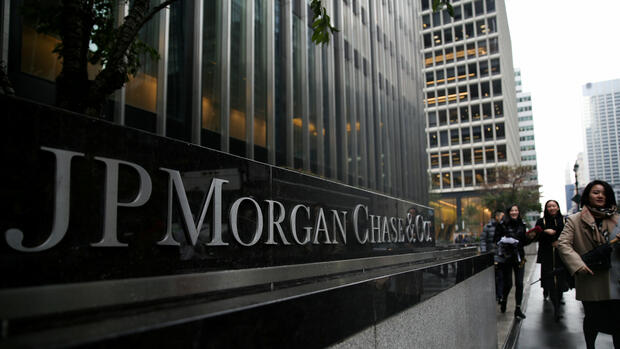new York A dichotomy is becoming apparent in America’s banking landscape: Big banks such as JP Morgan Chase, Citigroup and Wells Fargo are benefiting from the significantly higher key interest rates, as the quarterly figures published on Friday show. Smaller banks, on the other hand, have come under extreme pressure precisely because of the high interest rates. The bankruptcy of the Silicon Valley Bank (SVB) in March was triggered by the consequences of high interest rates and triggered a crisis of confidence in America’s regional banks.
Smaller institutes, on the other hand, often had to lure savers with significantly higher interest rates. Analysts assume that this trend could intensify after the exit of SVB and New York’s Signature Bank.
At JP Morgan, net interest income rose 49 percent year-on-year to a record $20.7 billion. At Wells Fargo, it soared 45 percent to $13.3 billion. Citigroup posted an increase of 23 percent. The US Federal Reserve (Fed) initiated the turnaround in interest rates last March and has since raised the key interest rate at a rapid pace to the current range of 4.75 to 5.0 percent. The twelve-month comparison is therefore particularly advantageous for the large institutes.
After the SVB bankruptcy, they also benefited from the uncertainty that spread among the regional banks. Savers and companies withdrew deposits on a large scale and parked them at the big banks.
JP Morgan with particularly strong results
JP Morgan has attracted a good $50 billion in fresh deposits since the SVB exited, CFO Jeremy Barnum said on Friday. At Citigroup, it was a good $30 billion, mostly from medium-sized companies, according to Citi’s chief financial officer, Mark Mason.
But even the large institutes are feeling the competition from money market funds. They invest in short-term US Treasury bonds and other securities deemed particularly safe. They thus achieve returns of over four percent and have recently recorded record inflows. JP Morgan’s chief financial officer, Barnum, expects some of the new money market fund deposits to flow out.
America’s largest bank reported particularly strong results. Profits rose 52 percent on record earnings of $38.3 billion. At JP Morgan there is “no sign of a banking crisis,” commented Wells Fargo analyst Mike Mayo. The bank is “a port in a storm,” he clarified.
>> Read also: ‘No cracks in the banking system’: JP Morgan, Citi and Wells Fargo jump in profits
The Fed and other bank regulators could draw two main conclusions from the surprisingly strong results, analysts believe. For one thing, it paves the way for another rate hike at the next Fed meeting on May 3rd. A further rate hike of a quarter of a percentage point is under discussion. The hope that the Fed could pause interest rates so as not to unnecessarily endanger the stability of the financial system has now “vanished,” said Octavio Marenzi, head of the capital markets consultancy Opimas. Thus, the results are “good for banks, but bad for the broader market.”
Regional banks: The institutes are burdened by a series of problems
On the other hand, the deposit insurance fund FDIC could clamp the big institutes more tightly in order to replenish the coffers after the bank failures. The FDIC guarantees credits of up to $250,000 per customer per bank and resolves troubled banks. The fund estimates that the exit from SVB and Signature will cost $23 billion. Funds that have to be allocated to all banks. However, the FDIC is considering charging the big banks even more than before, as media reports indicate – also in order not to further weaken the smaller institutes.
The regional banks are suffering greatly from the sharp rise in interest rates. They incur book losses on the bonds they hold in their portfolios. That could become a problem if the paper has to be sold ahead of schedule, as was the case with Silicon Valley Bank. The Fed introduced a new lending program after the March bankruptcy. It allows banks to pledge the paper at face value as collateral and borrow money from the Fed. That has stabilized the situation in recent weeks, but a number of other problems are weighing on the institutes, as Rebel Cole, a finance professor at Florida Atlantic University, points out.
>> Read also: Concerns about US regional banks are growing
Increasing requirements for topics such as digital banking and cybersecurity have been increasing costs for years. In addition, the smaller institutes are often an important lender for the regional economy. They play a key role, especially in commercial real estate. According to calculations by Goldman Sachs, they hold a good 80 percent of these loans on their books. And the area is coming under increasing pressure given the continuing trend towards working from home and crumbling inner cities.
JP Morgan CEO Jamie Dimon warns against too much optimism
Analysts expect loan defaults and write-downs. Cole anticipates a wave of mergers among smaller banks. Traditionally, they do not hedge their interest rate risks as well as large institutes and also hold significantly more loans on their books.
Regional institutes will present their results in the coming days. Morgan Stanley analysts have revised their earnings estimates downwards by 20 percent. For 2024, they expect another decline of 30 percent.
Even JP Morgan CEO Jamie Dimon warns against too much optimism. “The US economy remains on sound footing,” he said. But storm clouds remained on the horizon. Financing conditions are expected to tighten further as banks become more restrictive on lending. Overall, this leads to great uncertainty in the outlook for the coming quarters. Investment banking also continued to be weak in the first quarter. That could weigh particularly heavily on Goldman Sachs and Morgan Stanley. The institutes present their figures on Tuesday and Wednesday respectively.
More: US money market funds are booming – and endangering the financial system from two sides
